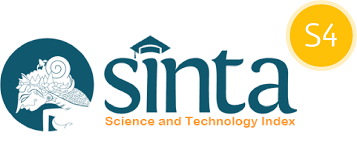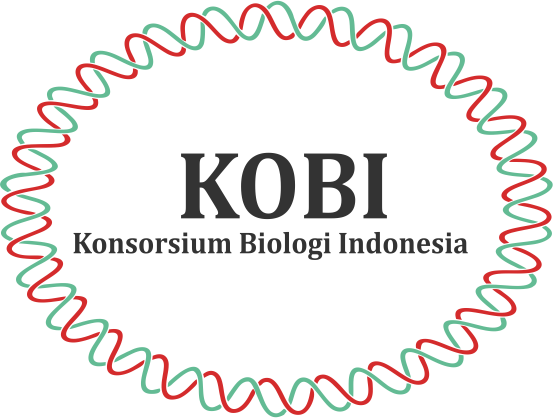Reverse Transcriptase PCR (Rt-PCR) for Detection of Dengue and Chikungunya Virus of Mosquito Aedes aegypti in Sokaraja
Abstract
dengue fever (DF). Meanwhile, chikungunya virus causes Chikungunya fever (CF). These diseases involve three organisms, namely virus, mosquito Aedes sp., and human. The transmission of dengue and chikungunya virus is related to the population of Ae. aegypti. Banyumas regency is one of the regions with many cases of dengue and chikungnya virus infections, particularly in Purwokerto, Sokaraja, and Cilongok sub-district. Up to this time, there is no medicine and vaccine provided to treat these viruses effectively. Thus, detection of virus inside vector will be effectively performed in order to predict the transmission risk of dengue and chikungunya virus. This research aimed to know the molecular detection of dengue and chikungunya virus on adult Ae.aegypti mosquito in Sokaraja Region, Banyumas Regency. Survey was done by a cross-sectional method in Sokaraja sub-district from May 2019 – March 2019. Furthermore, technical sampling that used was purposive sampling method of adult Ae.aegypti using BG-Sentital Trap, followed by molecular detection of dengue virus using Two-step RT-PCR and chikungunya gene virus using RT-PCR. Molecular detection of DENV and CHIKV of mosquitoes which collected from Sokaraja region showed negative result
References
Central Java Health Office, 2017. Health Profile of Central Java Year 2017. Semarang: Central Java Health Office.
Farraudière, L., Sonor, F.,Crico, S., Etienne, M., Mousson, L., Hamel, R., Misse, D., Failloux, A.B., Simard, F. & Yebakima, A., 2017. First Detection of Dengue and Chikungunya Viruses in Natural Populations of Aedes aegypti in Martinique During The 2013 – 2015 Concomitant Outbreak. Rev Panam Salud Publica, 41:1-3.
Harian Banyumas, 2013. 20 Warga Terserang Chikungunya. Harian Banyumas, 26 November: 4-5.
Karyanti, R. M., Uiterwaal, C.S. P. M, Kusriastuti, R., Hadinegoro, S.R., Rovers, M. M., Heesterbeek, H., Hoes, A. W.& Bruijning-Verhage, P., 2014. The Changing Incidence of Dengue Haemorrhagic Fever in Indonesia: A 45 Year Registry Based Analysis. Infection Disease, 14(412): 1-7.
Karyanti, R. M., Uiterwaal, C.S. P. M, Kusriastuti, R., Hadinegoro, S.R., Rovers, M. M., Heesterbeek, H., Hoes, A. W.& Bruijning-Verhage, P., 2014. The Changing Incidence of Dengue Haemorrhagic Fever in Indonesia: A 45 Year Registry Based Analysis. Infection Disease, 14(412): 1-7.
Kraemer, M. U. Sinka, M.E., Duda, K.A., Mylne, A.Q.N., Shearer, F.M., Barker, C.M., Moore, C.G., Carvalho, R.G., Coelho, G, E., Bortel, W.V., Hendrickx, G., Schaffner, F., Elyazar, I.R.F., Teng, H., Brady, O.J., Messina, J.P., Pigott, D.M., Scott,T.W., Smith, D.L., Wint, G.R.W., Golding, N. & Hay, S.I., 2015. The Global Distribution of The Arbovirus Vectors Aedes aegypti and Ae. albopictus. eLife Research Article, 4: 1-18.
Mahmud, S., Ahmed, S. S. & Hussain, M., 2017. Chikungunya Fever: A Global Burden Including Bangladesh. International Journal of Scientific Research, 6(7): 542-546.
Ministry of Health Republic of Indonesia, 2016. Info Datin. Pusat Data dan Informasi Kementria Kesehatan RI, 22nd April:1-10.
Ministry of Health Republic of Indonesia, 2016. Info Datin. Pusat Data dan Informasi Kementria Kesehatan RI, 22nd April: 1-10.
Muktar, Y., Tamerat , N. & Shewafer, A., 2016. Aedes aegypti as a Vector of Flavivirus. Journal of Tropical Diseases, 4(5): 1-7.
Nasir, S. Jabeen, F., Abbas, S., Nasir, I.& Debboun, M., 2017. Effect of Climatic Conditions and Water Bodies on Population Dynamics of the Dengue Vector, Aedes aegypti (Diptera: Culicidae). Journal Arthropod-Borne Dis, 11(1): 50-59.
Ooi, EE and Gubler, DJ. 2008. Dengue in Southeast Asia: Epidemiological Characteristics and Strategic Challenges in Disease Prevention. Artigo, 25(1): 115–124
Pesko K, Westbrook CJ, Mores CN, Lounibos LP, Reiskind MH. Effects of infectious virus dose and bloodmeal delivery method on susceptibility of Aedes aegypti and Aedes albopictus to Chikungunya Virus. Journal Medical Entomology. 2009; 46(2):395 –399
Pratama , A. D. & Pawenang, E. T., 2017. Analisis Faktor Intrinsik dan Ekstrinsik Kejadian Penyakit. Higeia Journal of Public Health Research and Development, 1(3): 11-20.
Sari, T. F., Joharina, A. S. & Anggraeni, Y. M., 2012. Identifikasi Serotipe Virus Dengue Pada Nyamuk Aedes aegypti dan Aedes albopictus di Kota Salatiga dengan Metode RT-PCR. Salatiga: Balai Besar Penelitiana dan Pengembangan Vektor dan Reservoir Penyakit Salatiga.
Sunaryo & Pramestuti, N., 2014. Aedes aegypti Surveillance in Endemic Area of Dengue Haemorrhagic Fever. Jurnal Kesehatan Masyarakat Nasional, 8(8): 423-429.
Sus, 2015. 36 Desa/ Kelurahan Endemis DBD. Radar Banyumas, 5 December.
Susanti, L., Yuniarti, R. & Trapsilowati, W., 2014. Risk Factors of Chikungunya In Boyolali District, Central Java Province. BUl. Penelitian Kesehatan, 42(1): 1-14
Tut, 2013. Banyumas News. [Online] Available at: https://banyumasnews.com
[Accessed 24 January 2019].
Wahyono, T. Y., Nealon, J., Beucher, S., Prayitno, A., Moureau, A., Nawawi, S., Thabrany, H.& Nadjib, M., 2017. Indonesian Dengue Burden Estimates: Review of Evidence by An Expert Panel. Epidemiol. Infect, 145: 2324-2329.
WHO, 2012. Global Strategy for Dengue Prevention and Control 2012-2020. Geneva: World Health Organization.
Yuniarti, R. A., 2011. Studi Rekonfirmasi Penyakit Chikungunya di Daerah Endemis Jawa Tengah, Salatiga: B2P2VRP.
Zeller, H., Bortel, W. V. & Sudre, B., 2016. Chikungunya: Its History in Africa and Asia and Its Spread to New Regions in 2013-2014. Journal of Infectious Disease, 214(5): 436-440.














_copy.png)



